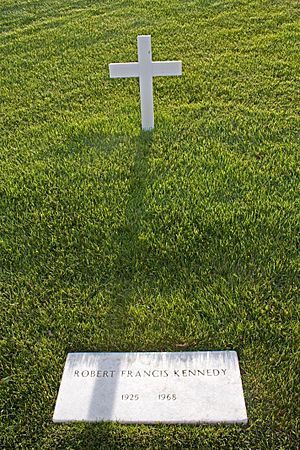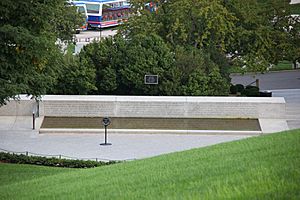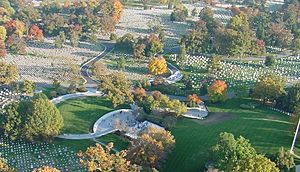Grave of Robert F. Kennedy facts for kids
The grave of Robert F. Kennedy is a special place in Arlington National Cemetery in Arlington County, Virginia. It's a memorial for Robert F. Kennedy, who was a U.S. Senator and ran for president in 1968 before he was assassinated. His grave is next to the John F. Kennedy Eternal Flame, which honors his brother, President John F. Kennedy.
The grave faces east and west, looking towards Arlington House and the Jefferson Memorial. It has a simple white wooden cross at one end and a flat grey granite stone at the other. The memorial area includes a small, curved granite space for visitors. Behind this space is a low grey granite wall with famous quotes from Kennedy's speeches. A shallow reflecting pool sits at the base of this wall.
Contents
Robert F. Kennedy's First Burial
Robert F. Kennedy was shot and badly wounded on June 5, 1968. He passed away early on June 6. His body was flown to New York City on Air Force One. It rested in St. Patrick's Cathedral for a day before his funeral.
The Kennedy family quickly decided where he would be buried. Even though Robert Kennedy had wanted to be buried in the family plot in Massachusetts, his family chose Arlington National Cemetery. They wanted him to be near his brother, John F. Kennedy. Officials from the Department of Defense helped the family choose a spot near John F. Kennedy's grave. On June 7, the family announced that Robert F. Kennedy would be buried in a grassy area southeast of his brother's site.
A special funeral mass was held at St. Patrick's Cathedral on June 8. Many important people attended, including his wife Ethel Kennedy, his children, Jacqueline Kennedy, and President Lyndon B. Johnson. After the service, Kennedy's body traveled by train from New York City to Washington, D.C.. The journey, which usually took four hours, lasted over eight hours. This was because huge crowds lined the tracks to pay their respects.
The funeral train arrived in Washington at 9:10 PM. All the funeral flowers were taken to Arlington National Cemetery. Floodlights were quickly set up to light the burial area. Over 1,500 candles were given to the crowd. As the funeral cars entered the cemetery, people lit their candles, creating a path of light. The service began at 10:30 PM and ended at 10:45 PM. After family and friends left, Kennedy's coffin was lowered into the ground at 11:34 PM.
Cemetery officials have said that Robert F. Kennedy's burial was the only one ever to happen at night in Arlington. However, two of John F. Kennedy's infant children were also buried at night in 1963. Senator Edward M. Kennedy was also buried at night in 2009.
Like his brother, Robert Kennedy's first grave was temporary. It was about 10 feet uphill from its current spot. A simple white wooden cross marked the head of the grave. Many people visited the grave in the days after the burial. Over 7 million people visited both Kennedy graves in the first year.
Designing the Permanent Grave and Memorial
The U.S. Army worked with the Kennedy family to design a permanent grave and memorial. The family decided to build a memorial in late 1968. Ethel Kennedy chose I. M. Pei as the architect. Pei was a famous architect who had worked with Robert Kennedy before. He was also chosen to design the John F. Kennedy Presidential Library and Museum.
Pei's design for Robert Kennedy's grave was similar to John F. Kennedy's site but smaller. The family wanted Robert Kennedy's grave to be very simple. They chose only a white cross and a flat stone marker. Pei's plan included planting trees around the grave.
The memorial design featured a small, curved plaza. It had a low grey granite wall with quotes from Robert Kennedy's speeches. A shallow reflecting pool was placed at the base of this wall. A straight granite path connected this memorial to John F. Kennedy's grave. Trees were planned to separate the two sites and create a peaceful area.
Pei finished the design quickly. The Kennedy family agreed to pay 58 percent of the total cost for the grave and memorial. The government paid for things like roads, landscaping, and utilities. The total cost was estimated at about $1,016,000. The plans were approved by the Kennedy family and several government groups.
Using public money for the memorial caused some debate. Some people felt it was wrong to spend government funds on a private citizen's memorial. Others wondered why a U.S. Senator received such special treatment. However, many, including Senator Charles H. Percy, argued that the improvements were needed. They said it would prevent damage to the cemetery from the many visitors.
The U.S. Army asked for $431,000 for its share in 1969. However, President Johnson removed this request from the Army's budget. He put it into a special presidential fund instead. This meant the next president, Richard Nixon, would decide. In February 1969, President Nixon approved the money.
On June 6, 1969, the Army announced the memorial would cost $677,000. The Kennedys would pay about 62 percent and cover any extra costs. Construction would begin once Congress approved the funds. Some members of Congress still disagreed with using federal money for the memorial. However, the House of Representatives voted against removing the funds.
In 1970, the cost was still estimated at $677,000. The Kennedys would pay about 62 percent. A construction company was hired in October 1970 for $527,914. The total project cost became $747,000, with the Kennedy family now paying about 75.8 percent. Construction started in November 1970 and was expected to take a year. The paths to both Kennedy graves were changed during this time. The steps were replaced with ramps in June 1971, making the area more accessible for people in wheelchairs.
Final Design and Dedication
Robert F. Kennedy's body was moved to the new grave site on December 1, 1971. His wife and brother, Edward M. Kennedy, were present. The reburial was finished around 9:00 PM. The final grave and granite plaza were officially dedicated on December 6, 1971.
Robert Kennedy's final resting place is about 50 feet southwest of John F. Kennedy's grave. His burial vault has a white wooden cross at its head. A flat slate headstone is at its foot. The low granite wall at the back of the plaza has quotes from two of Robert F. Kennedy's famous speeches. A small reflecting pool is at the base of the wall. The granite for the plaza came from Deer Isle, Maine, the same place as the granite for John F. Kennedy's grave.
One quote, which inspired the reflecting pool, is from a speech Kennedy gave in South Africa in 1966. It talks about how small acts of courage create a "ripple of hope" that can change the world.
It is from numberless diverse acts of courage and belief that human history is shaped each time a man stands up for an ideal or acts to improve the lot of others or strikes out against injustice. He sends forth a tiny ripple of hope, and crossing each other from a million different centers of energy and daring, those ripples build a current that can sweep down the mightiest wall of oppression and resistance.
The second quote is from a speech Kennedy gave in Indianapolis, Indiana, on the night Martin Luther King Jr. was assassinated. It speaks about the need for love, wisdom, and justice.
Aeschylus...wrote, "Even in our sleep, pain which cannot forget falls drop by drop upon the heart, until, in our own despair, against our will, comes wisdom through the awful grace of God.' What we need in the United States is not division; what we need in the United States is not hatred; what we need in the United States is not violence and lawlessness; but is love and wisdom, and compassion toward one another, and a feeling of justice toward those who still suffer within our country, whether they be white or whether they be black.
The final cost of the grave and memorial was $747,000. Journalist Evan Thomas later wrote that the memorial feels lonely and sad.
Vandalism and Theft
On January 4, 1970, vandals pulled out the white cross at Kennedy's grave. Cemetery officials quickly put it back the same day.
In 1981, the cross and footstone marking Robert F. Kennedy's grave were stolen. They were never found and had to be replaced.
Images for kids







